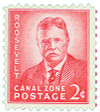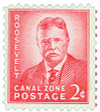
# CZ138 - 1946-49 2c Canal Zone - Roosevelt, unwatermarked, light rose carmine
CZ138 – 1946-49 2¢ Roosevelt
Following President McKinley's assassination, his successor Theodore Roosevelt saw the canal as vital to America’s role as a global power. With negotiations underway in both Nicaragua and Panama, Roosevelt’s strained relationship with Columbia and the asking price of $100 million for the Panama venture could have tipped the scales in favor of a Nicaraguan canal. However, a Nicaraguan postage stamp helped persuade the U.S. Senate’s decision.
In November of 1906, President Theodore Roosevelt became the first President to travel outside the continental United States. His visit to the Panama Canal Zone reflected an evolution in his views regarding the canal’s role in the world.
Roosevelt Takes First Presidential Trip Outside U.S.
On November 9, 1906, Theodore Roosevelt visited the Panama Canal Zone, marking the first time a sitting U.S. President visited another country.
Proposals for a canal across Nicaragua or Panama began as early as 1889. United States public opinion of the canal was generally unfavorable until 1898, when an explosion aboard the Maine sank the battleship at a Cuban naval base.
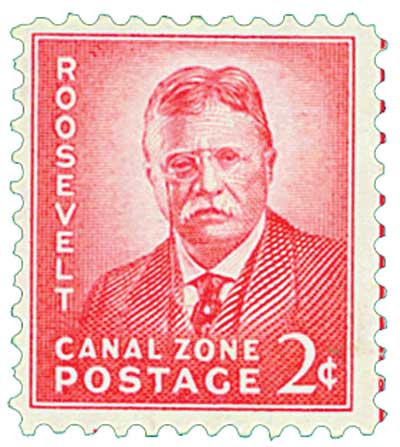
As the Spanish-American War loomed, the battleship Oregon sailed through San Francisco’s Golden Gates to save the day. The eyes of the world were on its 16,000-mile course around Cape Horn and through the dangerous Straits of Magellan. The 67-day journey clearly showed the military significance of an isthmian canal. However, President McKinley was assassinated before he could negotiate rights to a canal.
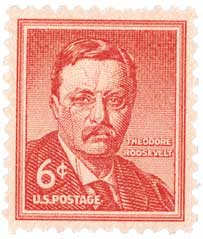
McKinley’s successor, Theodore Roosevelt, saw the canal as vital to America’s role as a global power. With negotiations underway in both Nicaragua and Panama, Roosevelt’s strained relationship with Columbia and the asking price of $100 million for the Panama venture could have tipped the scales in favor of a Nicaraguan canal. However, a Nicaraguan postage stamp picturing an active volcano that would threaten the Nicaraguan canal helped persuade the U.S. Senate’s decision. Construction in Panama began in 1904.
On November 9, 1906, President Theodore Roosevelt became the first President to travel outside the continental United States when he spent 17 days in the Panama Canal Zone and Puerto Rico. His visit to the Panama Canal Zone reflected an evolution in his views regarding the canal’s role in the world. While he initially spoke of the canal in terms of a political, commercial, and military necessity, Roosevelt now allowed himself to be inspired by the romance of the project. Roosevelt spoke of the dramatic challenges in its structural design and of the tremendous difficulties that must be overcome to complete the project – a mighty battle involving both national honor and that of the work force.
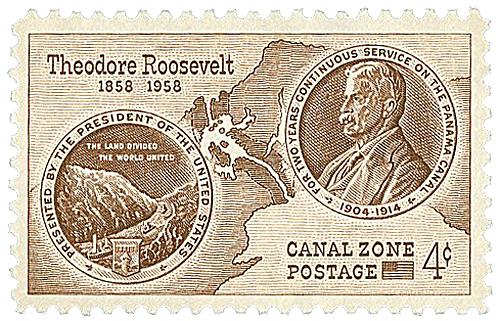
At the end of his last day in the Canal Zone, Roosevelt addressed the workers:
“…whoever you are, if you are doing your duty, the balance of the country is placed under obligation to you, just as it is to a soldier in a great war. The man who does his duty, no matter in what position he may be placed, is the man for the job. But to do your duty you must do a little more than just earn your salary. As I have looked at you and seen you work, seen what you have done and are doing, I have felt just exactly as I would feel to see the big men of our country carrying on a great war.
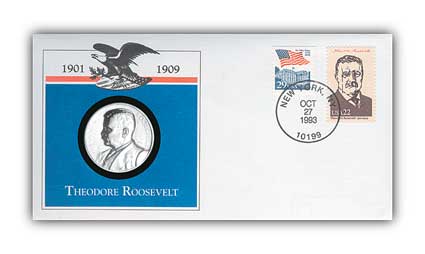
You here who are doing your work well in bringing to completion this great enterprise, are standing exactly as a soldier of the few great wars of the world’s history. This is one of the great works of the world. It is a greater work than you yourselves at the moment realize.
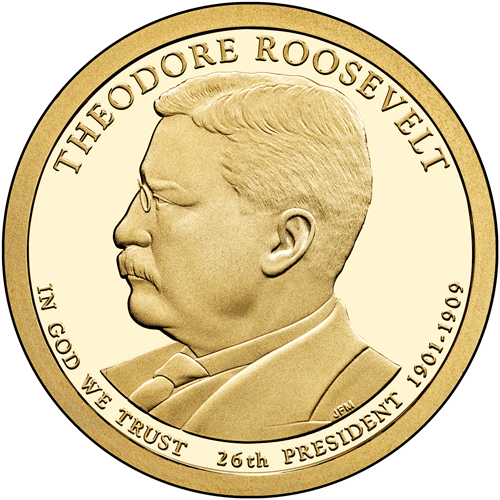
In the Grand Army the spirit that appeals to me is the spirit of fellowship, of comradeship. If a man was a lieutenant general of the army or if he was the last recruit, the youngest recruit whose age would permit him to serve in the ranks, it makes no difference. If he did his duty well, he is a comrade, and recognized in every Grand Army post. And so it should be with you, whether you be chief engineer, superintendent, foreman, steam shovel man, machinist, clerk – this spirit of comradeship should prevail.”
Roosevelt’s visit helped boost morale on the project as well as worker conditions and healthcare in the Canal Zone.
While he initially spoke of the canal in terms of a political, commercial, and military necessity, Roosevelt now allowed himself to be inspired by the romance of the project. Roosevelt spoke of the dramatic challenges in its structural design and of the tremendous difficulties that must be overcome to complete the project – a mighty battle involving both national honor and that of the work force.
Canal Zone Stamps Chronicle America’s Rise as a World Power
If you’ve never collected Canal Zone stamps before, now’s the time to start. These intriguing stamps are historic links to our nation’s past. With Mystic as your collecting partner, it’s easy to own stamps documenting this remarkable American engineering feat!
With military assistance from the United States, Panama declared its independence from Columbia on November 3, 1903. The Hay-Bunau-Varilla Treaty was negotiated, than ratified in Panama on December 2, 1903. The United States followed suit on February 23, 1904, clearing the way for a long-anticipated canal project across the Panama isthmus.
Almost immediately, administrators began preparations for the tremendous influx of people who would eventually assemble to work on the project. Faced with the knowledge that most of the work force would be imported to the region from America and Caribbean countries, authorities quickly established a postal service to serve their needs as well as those of the Canal Commission.
On June 24, 1904, postal service was established as part of the U.S. Department of Revenue under the supervision of the Treasurer of the Canal Zone, Paymaster E.C. Tobey. On this day, post offices were opened in Ancon, Cristóbal, Gatun, Culebra, and Balboa. Railroad station agents operated as postmasters.
A small supply of 2¢, 5¢, and 10¢ Panama stamps were overprinted “Canal Zone.” Only ordinary mail was handled by the Canal Zone postal system. Mail destined for Central and South America and the West Indies was turned over to the Panama postal service to be forwarded, while mail sent to the United States and its territories and possessions were sent to the U.S. aboard vessels departing for New York.
Overprinted Panama stamps were in use for less than a month. On July 18, 1904, they were replaced by U.S. postage stamps overprinted “Canal Zone.”
In December of 1904, Secretary of War William Taft ordered the overprinted U.S. stamps to be withdrawn, and replaced them with overprinted Panama stamps. Taft’s executive order was reversed in 1924, when overprinted U.S. stamps were placed in use again.
On October 1, 1928, the first permanent issue Canal Zone stamp was issued. The 2¢ stamp featured Lt. Col. George W. Goethal, the Canal project’s chief engineer and first Canal Zone governor.
In 1929, the first Canal Zone Airmail stamp was issued and in 1941, a series of Officials were produced. On October 25, 1978, the last Canal Zone stamp was issued.
CZ138 – 1946-49 2¢ Roosevelt
Following President McKinley's assassination, his successor Theodore Roosevelt saw the canal as vital to America’s role as a global power. With negotiations underway in both Nicaragua and Panama, Roosevelt’s strained relationship with Columbia and the asking price of $100 million for the Panama venture could have tipped the scales in favor of a Nicaraguan canal. However, a Nicaraguan postage stamp helped persuade the U.S. Senate’s decision.
In November of 1906, President Theodore Roosevelt became the first President to travel outside the continental United States. His visit to the Panama Canal Zone reflected an evolution in his views regarding the canal’s role in the world.
Roosevelt Takes First Presidential Trip Outside U.S.
On November 9, 1906, Theodore Roosevelt visited the Panama Canal Zone, marking the first time a sitting U.S. President visited another country.
Proposals for a canal across Nicaragua or Panama began as early as 1889. United States public opinion of the canal was generally unfavorable until 1898, when an explosion aboard the Maine sank the battleship at a Cuban naval base.

As the Spanish-American War loomed, the battleship Oregon sailed through San Francisco’s Golden Gates to save the day. The eyes of the world were on its 16,000-mile course around Cape Horn and through the dangerous Straits of Magellan. The 67-day journey clearly showed the military significance of an isthmian canal. However, President McKinley was assassinated before he could negotiate rights to a canal.

McKinley’s successor, Theodore Roosevelt, saw the canal as vital to America’s role as a global power. With negotiations underway in both Nicaragua and Panama, Roosevelt’s strained relationship with Columbia and the asking price of $100 million for the Panama venture could have tipped the scales in favor of a Nicaraguan canal. However, a Nicaraguan postage stamp picturing an active volcano that would threaten the Nicaraguan canal helped persuade the U.S. Senate’s decision. Construction in Panama began in 1904.
On November 9, 1906, President Theodore Roosevelt became the first President to travel outside the continental United States when he spent 17 days in the Panama Canal Zone and Puerto Rico. His visit to the Panama Canal Zone reflected an evolution in his views regarding the canal’s role in the world. While he initially spoke of the canal in terms of a political, commercial, and military necessity, Roosevelt now allowed himself to be inspired by the romance of the project. Roosevelt spoke of the dramatic challenges in its structural design and of the tremendous difficulties that must be overcome to complete the project – a mighty battle involving both national honor and that of the work force.

At the end of his last day in the Canal Zone, Roosevelt addressed the workers:
“…whoever you are, if you are doing your duty, the balance of the country is placed under obligation to you, just as it is to a soldier in a great war. The man who does his duty, no matter in what position he may be placed, is the man for the job. But to do your duty you must do a little more than just earn your salary. As I have looked at you and seen you work, seen what you have done and are doing, I have felt just exactly as I would feel to see the big men of our country carrying on a great war.

You here who are doing your work well in bringing to completion this great enterprise, are standing exactly as a soldier of the few great wars of the world’s history. This is one of the great works of the world. It is a greater work than you yourselves at the moment realize.

In the Grand Army the spirit that appeals to me is the spirit of fellowship, of comradeship. If a man was a lieutenant general of the army or if he was the last recruit, the youngest recruit whose age would permit him to serve in the ranks, it makes no difference. If he did his duty well, he is a comrade, and recognized in every Grand Army post. And so it should be with you, whether you be chief engineer, superintendent, foreman, steam shovel man, machinist, clerk – this spirit of comradeship should prevail.”
Roosevelt’s visit helped boost morale on the project as well as worker conditions and healthcare in the Canal Zone.
While he initially spoke of the canal in terms of a political, commercial, and military necessity, Roosevelt now allowed himself to be inspired by the romance of the project. Roosevelt spoke of the dramatic challenges in its structural design and of the tremendous difficulties that must be overcome to complete the project – a mighty battle involving both national honor and that of the work force.
Canal Zone Stamps Chronicle America’s Rise as a World Power
If you’ve never collected Canal Zone stamps before, now’s the time to start. These intriguing stamps are historic links to our nation’s past. With Mystic as your collecting partner, it’s easy to own stamps documenting this remarkable American engineering feat!
With military assistance from the United States, Panama declared its independence from Columbia on November 3, 1903. The Hay-Bunau-Varilla Treaty was negotiated, than ratified in Panama on December 2, 1903. The United States followed suit on February 23, 1904, clearing the way for a long-anticipated canal project across the Panama isthmus.
Almost immediately, administrators began preparations for the tremendous influx of people who would eventually assemble to work on the project. Faced with the knowledge that most of the work force would be imported to the region from America and Caribbean countries, authorities quickly established a postal service to serve their needs as well as those of the Canal Commission.
On June 24, 1904, postal service was established as part of the U.S. Department of Revenue under the supervision of the Treasurer of the Canal Zone, Paymaster E.C. Tobey. On this day, post offices were opened in Ancon, Cristóbal, Gatun, Culebra, and Balboa. Railroad station agents operated as postmasters.
A small supply of 2¢, 5¢, and 10¢ Panama stamps were overprinted “Canal Zone.” Only ordinary mail was handled by the Canal Zone postal system. Mail destined for Central and South America and the West Indies was turned over to the Panama postal service to be forwarded, while mail sent to the United States and its territories and possessions were sent to the U.S. aboard vessels departing for New York.
Overprinted Panama stamps were in use for less than a month. On July 18, 1904, they were replaced by U.S. postage stamps overprinted “Canal Zone.”
In December of 1904, Secretary of War William Taft ordered the overprinted U.S. stamps to be withdrawn, and replaced them with overprinted Panama stamps. Taft’s executive order was reversed in 1924, when overprinted U.S. stamps were placed in use again.
On October 1, 1928, the first permanent issue Canal Zone stamp was issued. The 2¢ stamp featured Lt. Col. George W. Goethal, the Canal project’s chief engineer and first Canal Zone governor.
In 1929, the first Canal Zone Airmail stamp was issued and in 1941, a series of Officials were produced. On October 25, 1978, the last Canal Zone stamp was issued.




